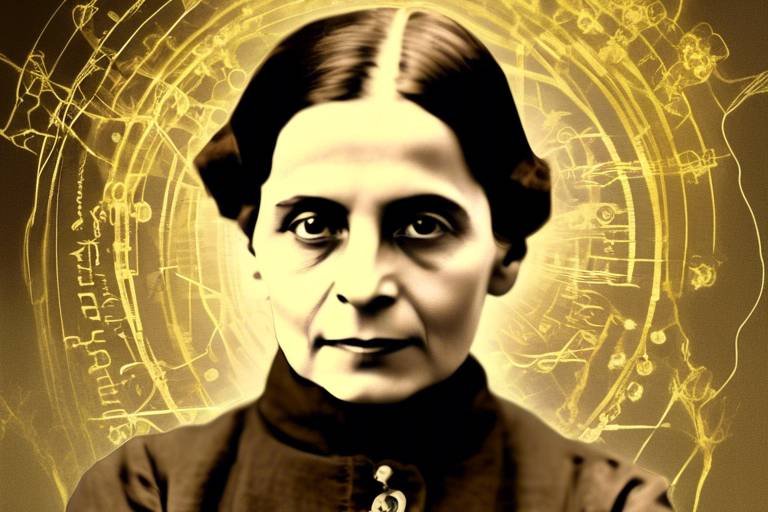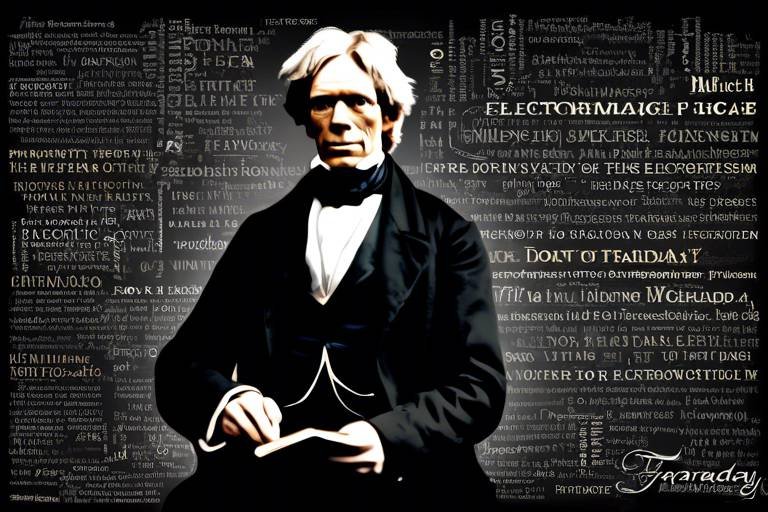Aldini: The Innovator in Galvanism
Giovanni Aldini, a name that resonates with innovation and curiosity in the realm of galvanism. His pioneering work in the field of electricity and its effects on the human body has left an indelible mark on the history of science. Aldini's relentless pursuit of knowledge and his daring experiments have paved the way for modern neuroscience and medical technology.

Early Life and Education
Giovanni Aldini, born in 1762 in Bologna, Italy, was immersed in a family deeply rooted in scientific exploration. His uncle, Luigi Galvani, a renowned physicist, played a significant role in shaping Aldini's early fascination with electricity and its effects on living organisms. Growing up in this environment, Aldini's curiosity and passion for science were nurtured from a young age.
As he embarked on his academic journey, Aldini pursued studies in medicine and physics, blending his interests to delve into the emerging field of galvanism. His educational background equipped him with the knowledge and skills necessary to conduct groundbreaking experiments that would later revolutionize the understanding of electrical stimulation on the human body.
During his formative years, Aldini was exposed to the works of leading scientists and thinkers of his time, influencing his approach to scientific inquiry and innovation. His education not only provided him with a solid foundation in traditional medical practices but also sparked his pioneering spirit to explore the uncharted territories of electricity and its potential applications in medicine.

Experiments with Animal Bodies
During his pioneering research in the field of galvanism, Giovanni Aldini conducted groundbreaking experiments involving the application of electrical currents to animal bodies. These experiments were not only innovative but also controversial, as they challenged conventional beliefs about the relationship between electricity and muscle movement.
One of Aldini's most famous experiments involved the application of electrical stimulation to the body of an executed criminal. This demonstration showcased the ability of electricity to induce muscle contractions, leading to movements that appeared lifelike to observers. The spectacle of a once lifeless body twitching and jerking under the influence of electrical currents captivated audiences and sparked both awe and fear.
In another notable experiment, Aldini applied electrical stimulation to the legs of a decapitated ox. The results were astonishing, as the legs kicked and moved as if the animal were still alive. This demonstration not only highlighted the connection between electricity and muscle function but also raised ethical questions about the boundaries of scientific inquiry.
Through his experiments with animal bodies, Aldini sought to unravel the mysteries of galvanism and its potential applications in medical science. His innovative approach to studying the effects of electricity on living organisms laid the groundwork for future advancements in neurology, physiology, and medical technology.

Application in Medical Science
Giovanni Aldini's experiments with galvanism had a profound impact on the field of medical science, revolutionizing the way researchers approached the study of the human body and its electrical properties. By applying electrical currents to animal bodies, Aldini was able to observe the effects on muscle movement and nerve stimulation, laying the groundwork for modern neurology and physiology.
One of the key applications of Aldini's work in medical science was the exploration of the relationship between electricity and the nervous system. His experiments provided valuable insights into how electrical impulses could be used to stimulate muscle contractions and even restore function in paralyzed limbs. This groundbreaking research opened up new possibilities for treating neurological disorders and spinal cord injuries.
Furthermore, Aldini's experiments with galvanism paved the way for the development of electrotherapy, a medical treatment that utilizes electrical stimulation to address various health conditions. From pain management to muscle rehabilitation, the application of electrical currents in medical settings continues to be a valuable tool thanks to Aldini's pioneering work.
In addition to direct medical applications, Aldini's research also inspired further exploration into the role of electricity in the body's physiological processes. His work sparked interest in bioelectricity and the use of electrical signals to understand and manipulate biological functions, leading to advancements in fields such as bioengineering and medical technology.

Public Demonstrations and Controversies
Giovanni Aldini's public demonstrations of galvanism were both captivating and controversial. By applying electrical currents to the bodies of deceased animals and sometimes even humans, Aldini aimed to showcase the effects of electricity on muscle movement and nerve stimulation. These demonstrations often drew large crowds, with spectators in awe of the seemingly miraculous reactions produced by the application of electrical currents.
However, Aldini's work also sparked intense controversies due to its unconventional and sometimes macabre nature. Critics raised ethical concerns about the use of human bodies in experiments and questioned the morality of manipulating the dead in such a manner. The sensationalized nature of Aldini's demonstrations also fueled rumors and fear, leading to widespread debates about the boundaries of scientific exploration and the implications of harnessing electricity for medical purposes.
Despite the controversies surrounding his work, Aldini's public demonstrations played a significant role in popularizing the concept of galvanism and sparking interest in the potential applications of electricity in medicine. His bold approach to showcasing the effects of electrical currents on the human body challenged traditional beliefs and paved the way for future advancements in neuroscience and physiology.

Impact on Popular Culture
Giovanni Aldini's pioneering work in galvanism not only revolutionized the field of science but also left a profound impact on popular culture during the Romantic era. His dramatic public demonstrations, where he applied electrical currents to animal and human bodies, captured the imagination of the public and inspired a wave of creativity across various artistic mediums.
One of the most notable impacts of Aldini's work on popular culture was its influence on literature. Writers and poets drew inspiration from Aldini's experiments, incorporating themes of electricity, life, and reanimation into their works. Mary Shelley's iconic novel "Frankenstein" is a prime example, with the character of Victor Frankenstein's experiments bearing striking similarities to Aldini's scientific pursuits.
Furthermore, Aldini's demonstrations sparked a fascination with the macabre and the unknown, leading to a surge in Gothic literature and art. Artists depicted eerie scenes of electrical experiments and reanimated bodies, reflecting the public's captivation with the intersection of science and the supernatural.
In addition to literature and art, Aldini's work also influenced popular culture through theatrical performances and public spectacles. His electrifying demonstrations, showcasing the power of electricity to animate lifeless bodies, became a source of both awe and controversy. Audiences were enthralled by the spectacle of galvanism, blurring the lines between science and entertainment.
Overall, Giovanni Aldini's impact on popular culture during the Romantic era was profound, shaping artistic expression and public fascination with the possibilities of electricity and the human body. His legacy continues to resonate in modern portrayals of science and the enduring allure of the mysterious and the miraculous.

Legacy and Influence
Giovanni Aldini's legacy in the scientific community is profound, with his pioneering work in galvanism laying the groundwork for significant advancements in the understanding of electricity and its effects on the human body. His innovative experiments not only captivated the scientific community but also sparked a wave of curiosity and exploration in the field of neuroscience and medical technology.
Through his relentless pursuit of knowledge and his daring experiments, Aldini inspired future generations of scientists to push the boundaries of conventional thinking and explore new frontiers in medical science. His contributions continue to resonate in modern research, serving as a reminder of the importance of curiosity, innovation, and bold experimentation in scientific discovery.
Furthermore, Aldini's influence extends beyond the realm of academia, as his work has left a lasting impact on popular culture. During the Romantic era, his public demonstrations fascinated audiences and sparked a wave of artistic and literary creations inspired by the intersection of science and humanity.
Today, Aldini's legacy lives on in the ongoing research and development of medical treatments and technologies that leverage the principles of galvanism. His pioneering spirit serves as a beacon for scientists and innovators, reminding them of the power of experimentation and the potential for groundbreaking discoveries in the field of neuroscience and physiology.

Modern Applications of Galvanism
Giovanni Aldini's groundbreaking experiments with galvanism have paved the way for numerous modern applications in the field of medical science. One of the key areas where galvanism finds contemporary relevance is in the treatment of certain medical conditions. For example, galvanic therapy, a form of electrotherapy inspired by Aldini's work, is used to stimulate muscle activity, improve circulation, and alleviate pain in patients suffering from various musculoskeletal disorders.
Furthermore, galvanism has found its place in modern prosthetics, where electrical stimulation is utilized to control prosthetic limbs and restore movement and functionality to individuals who have lost a limb. By harnessing the principles of galvanism, researchers and engineers have been able to develop advanced prosthetic devices that offer greater mobility and dexterity to amputees.
In addition to medical treatments, galvanism has also been incorporated into cosmetic procedures. Galvanic facials, for instance, use low-level electrical currents to enhance skin rejuvenation, improve blood circulation, and promote the absorption of skincare products. This innovative approach to skincare has gained popularity for its ability to achieve visible results in skin texture and tone.
Moreover, the principles of galvanism have been harnessed in the field of neuroscience to study brain function and neural pathways. Transcranial direct current stimulation (tDCS) is a technique that involves applying low electrical currents to specific areas of the brain, with potential applications in cognitive enhancement, mood regulation, and the treatment of neurological disorders.
Overall, the legacy of Giovanni Aldini lives on through the diverse modern applications of galvanism, showcasing the enduring impact of his pioneering experiments on the intersection of electricity and medicine.
Frequently Asked Questions
- What is galvanism?
Galvanism refers to the application of electrical currents to stimulate muscle contractions in biological tissues. It is named after Luigi Galvani, an Italian physician, physicist, and philosopher who first discovered the effects of electricity on muscle movement in the late 18th century.
- How did Giovanni Aldini contribute to galvanism?
Giovanni Aldini, the nephew of Luigi Galvani, furthered the study of galvanism by conducting experiments that involved applying electrical currents to animal and human bodies. His research helped advance our understanding of the relationship between electricity and nerve/muscle function, laying the groundwork for modern neuroscience and medical technology.
- What were some of Aldini's most famous experiments?
Aldini's most famous experiments involved applying electrical currents to the bodies of executed criminals to observe muscle movement. One notable demonstration was his public experiment on the corpse of George Forster, where he was able to make the deceased body's jaw and limbs move, shocking and intriguing audiences.
- How did Aldini's work impact medical science?
Aldini's work had a significant impact on medical science by pushing the boundaries of knowledge in neurology and physiology. His experiments helped inspire further research into the use of electricity in medical treatments, leading to advancements in areas such as nerve stimulation and muscle rehabilitation.
- What is the modern relevance of galvanism?
In modern times, galvanism continues to be used in various medical treatments and technologies. It is employed in procedures such as transcutaneous electrical nerve stimulation (TENS) for pain relief, as well as in deep brain stimulation for conditions like Parkinson's disease. Aldini's pioneering work laid the foundation for these contemporary applications of galvanism.



















